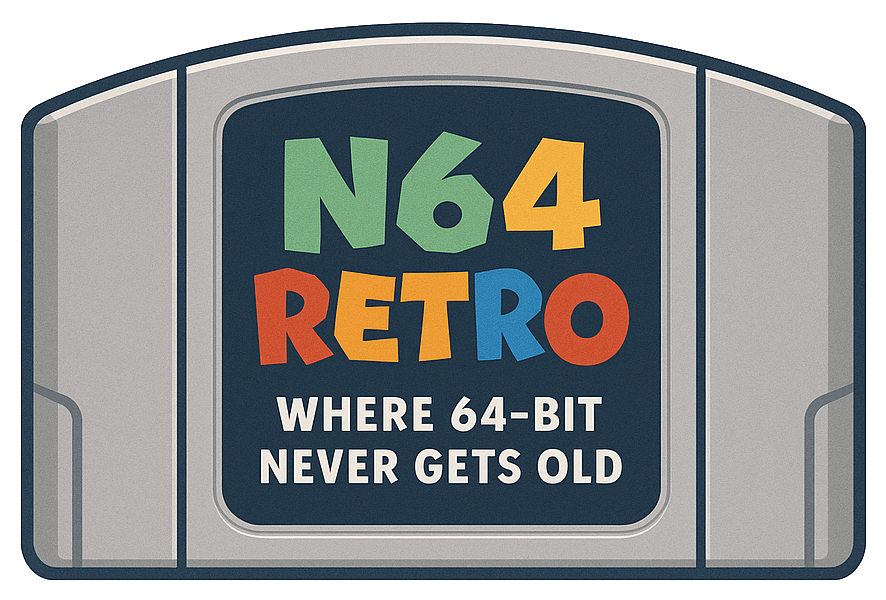The Hardware Accessories of the Nintendo 64: Innovation, Impact, and Legacy
When the Nintendo 64 (N64) launched in 1996, it brought the video game world into the era of full 3D gaming with its powerful (for the time) hardware, innovative controller, and unforgettable lineup of games. But alongside the base console and cartridges came a surprising range of hardware accessories. Some were widely adopted, while others slipped into obscurity. Taken together, they tell the story of Nintendo’s appetite for experimentation and how those experiments shaped both the N64 and the industry at large.
The N64 Controller: The Foundation of Everything
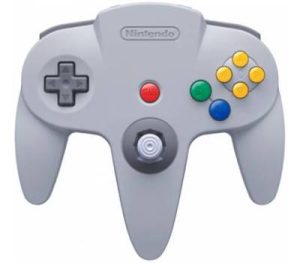
While technically bundled with the console rather than an optional accessory, the N64 controller itself deserves a mention because of its design and built-in expandability. The three-pronged controller was revolutionary in including an analog stick as its primary input method, making precise 3D movement possible in Super Mario 64 and beyond.
At the back of the controller was an expansion slot, which became the anchor point for nearly all of the console’s most important accessories — memory cards, rumble features, even special cartridge adapters. Without this design choice, the N64’s ecosystem of add-ons would never have existed in the same way. The analog stick’s impact is undeniable: today, no mainstream controller launches without one (or two).
Controller Pak (Memory Card)
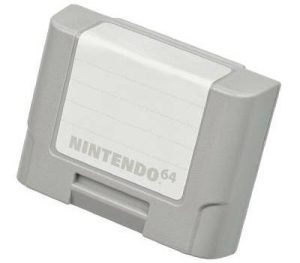 The Controller Pak, Nintendo’s version of a memory card, fit into the expansion slot of the controller and allowed players to save progress in games that didn’t use cartridge-based save chips. Titles like Mario Kart 64 and WinBack relied on it for saving ghost data, progress, or custom settings.
The Controller Pak, Nintendo’s version of a memory card, fit into the expansion slot of the controller and allowed players to save progress in games that didn’t use cartridge-based save chips. Titles like Mario Kart 64 and WinBack relied on it for saving ghost data, progress, or custom settings.
However, its adoption was inconsistent. Some games used cartridge saves, others required the Controller Pak, and some supported both. This inconsistency meant not every player owned one, but they were fairly widespread because popular multiplayer games used them.
Lasting impact: Memory cards became standard on later consoles, like the PlayStation and GameCube, though today they’ve been replaced by internal storage. The Controller Pak showed the usefulness of portable save data, particularly for multiplayer households.
Rumble Pak
 Arguably the N64’s most famous accessory, the Rumble Pak was introduced in 1997 alongside Star Fox 64. It added force feedback — vibrating in response to in-game actions like explosions, crashes, or weapon fire. At the time, it was a gimmick that quickly proved transformative, making games feel more immersive.
Arguably the N64’s most famous accessory, the Rumble Pak was introduced in 1997 alongside Star Fox 64. It added force feedback — vibrating in response to in-game actions like explosions, crashes, or weapon fire. At the time, it was a gimmick that quickly proved transformative, making games feel more immersive.
Players immediately embraced it. While it required AAA batteries and occupied the controller expansion slot (meaning you couldn’t use it and the Controller Pak simultaneously without swapping), the Rumble Pak became one of the console’s most successful accessories. Millions were sold, often bundled with Star Fox 64 and later compatible with a wide array of titles like GoldenEye 007 and Ocarina of Time.
Lasting impact: Haptic feedback is now standard in gaming. Sony, Microsoft, and Nintendo all built vibration into their controllers permanently after the Rumble Pak proved its worth. Modern refinements like the PlayStation 5’s DualSense adaptive triggers owe their lineage to this little battery-powered module.
Expansion Pak
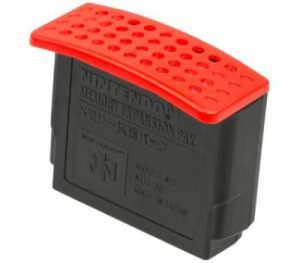 The Expansion Pak was a RAM upgrade that boosted the console’s memory from 4MB to 8MB. Released in 1998, it was originally tied to Donkey Kong 64 (which needed it due to a memory leak bug), but soon became essential for other titles.
The Expansion Pak was a RAM upgrade that boosted the console’s memory from 4MB to 8MB. Released in 1998, it was originally tied to Donkey Kong 64 (which needed it due to a memory leak bug), but soon became essential for other titles.
Some games like The Legend of Zelda: Majora’s Mask, Perfect Dark, and Turok 2 required the Expansion Pak to run at all. Others used it to enhance graphics, increase resolution, or unlock additional content. Despite starting as an optional upgrade, it became widespread because so many high-profile games took advantage of it.
Lasting impact: The Expansion Pak introduced the idea of mid-generation hardware upgrades. While rare at the time, the concept resurfaced in later eras with devices like the PlayStation 4 Pro, Xbox One X, and the PlayStation VR headset, showing that console hardware could evolve without requiring a brand-new system.
Transfer Pak
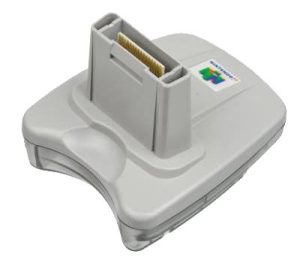 The Transfer Pak was a curious device that allowed Game Boy cartridges to interact with N64 titles. It plugged into the controller slot and became best known for its use with Pokémon Stadium (1999), where players could import Pokémon from Pokémon Red, Blue, and Yellow for use in 3D battles.
The Transfer Pak was a curious device that allowed Game Boy cartridges to interact with N64 titles. It plugged into the controller slot and became best known for its use with Pokémon Stadium (1999), where players could import Pokémon from Pokémon Red, Blue, and Yellow for use in 3D battles.
Outside of Pokémon, support was limited. A handful of games, like Mario Golf and Mario Tennis, used it to transfer characters and progress between handheld and console versions. Despite limited adoption, the Transfer Pak was beloved by Pokémon fans and helped sell the idea of cross-platform connectivity.
Lasting impact: The concept of linking handheld and console experiences foreshadowed Nintendo’s later strategies, from the GameCube–Game Boy Advance link cable to the hybrid design of the Nintendo Switch. Cross-play between mobile and console games today carries echoes of this idea.
Voice Recognition Unit (VRU)
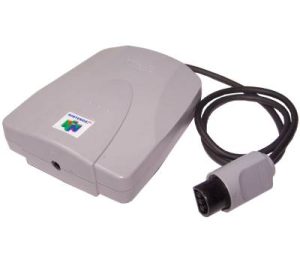 One of the N64’s more eccentric add-ons, the Voice Recognition Unit (VRU) was bundled with the quirky title Hey You, Pikachu! in 1998 (Japan) and 2000 (North America). The microphone connected to the controller and allowed players to issue voice commands to Pikachu.
One of the N64’s more eccentric add-ons, the Voice Recognition Unit (VRU) was bundled with the quirky title Hey You, Pikachu! in 1998 (Japan) and 2000 (North America). The microphone connected to the controller and allowed players to issue voice commands to Pikachu.
While technologically impressive for the time, it struggled with accuracy and only supported a couple of games. As such, it never became widespread, but it hinted at the potential of voice input long before virtual assistants like Siri or Alexa became mainstream.
Lasting impact: Though not a direct influence, the VRU can be seen as a primitive ancestor to later experiments with voice input in gaming, such as the Xbox Kinect or modern VR headsets with built-in microphones.
64DD (Disk Drive)
 Perhaps the most infamous N64 accessory, the 64DD (Disk Drive) was released only in Japan in 1999. It was a magnetic disk drive that attached beneath the console and allowed for rewritable storage, online connectivity (through the Randnet service), and larger games.
Perhaps the most infamous N64 accessory, the 64DD (Disk Drive) was released only in Japan in 1999. It was a magnetic disk drive that attached beneath the console and allowed for rewritable storage, online connectivity (through the Randnet service), and larger games.
Despite ambitious plans, only a handful of titles were released for it, such as Mario Artist and F-Zero Expansion Kit. With poor sales and limited support, it quickly fizzled out.
Lasting impact: Although a commercial failure, the 64DD was a testing ground for concepts that Nintendo later explored successfully, such as user-generated content (Mario Artist anticipated Mario Maker) and online connectivity, which became standard in future consoles.
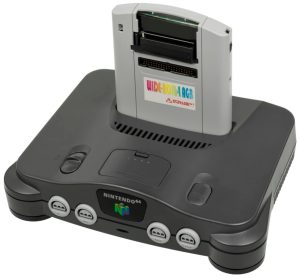
Other Accessories
Wideboy64: A developer-only device that allowed Game Boy games to be played on the N64 for testing and demo purposes. Never released to consumers but critical for development.
Third-Party Controllers and Accessories: A range of third-party pads, memory cards, and oddities like fishing rods and arcade sticks hit the market, though none had the cultural staying power of Nintendo’s own devices.
The Bigger Picture
Looking at the N64’s hardware ecosystem, a pattern emerges: Nintendo wasn’t afraid to experiment. Some ideas — like rumble and analog control — became industry standards. Others — like the 64DD or the VRU — became historical curiosities.
What set the N64 apart was how its accessories weren’t just gimmicks tacked on after the fact. Many were deeply tied to software: Star Fox 64 made the Rumble Pak indispensable; Majora’s Mask wouldn’t run without the Expansion Pak; Pokémon Stadium was incomplete without the Transfer Pak. This software-first approach meant that even the more niche accessories felt integral to the N64 experience for those who used them.
Conclusion
The Nintendo 64’s accessories ranged from revolutionary to forgettable, but together they represented an era when hardware was malleable, and creativity ran high. Millions of players experienced their first rumble, their first analog stick, or their first console–handheld connection thanks to these add-ons.
Some ideas flopped, others changed the industry forever, but all of them reinforced Nintendo’s reputation as a company willing to experiment with bold, playful hardware designs. In many ways, the DNA of the Switch and its Joy-Con controllers can be traced directly back to the odd but charming legacy of the N64’s accessories.
Variations of the Nintendo 64: Colours, Editions, and Collectibles
When the Nintendo 64 launched in 1996, it arrived in a simple charcoal-grey shell with a matching controller. Over its life, however, the console received a surprising number of variations, from colourful translucent plastics to limited-edition bundles tied to major games. These versions became collector favourites and reflected Nintendo’s flair for making its hardware feel playful and personal.
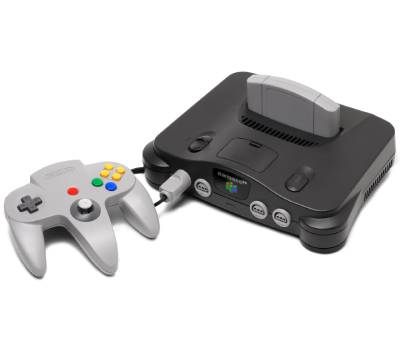
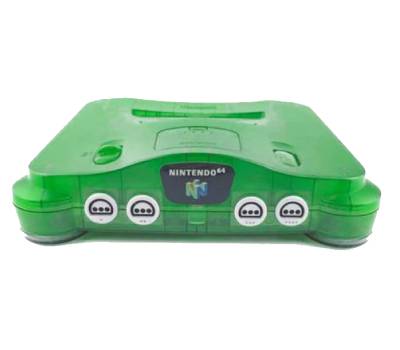
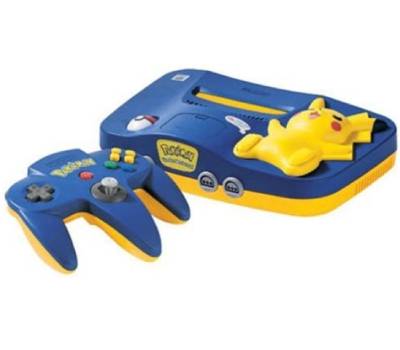
The Original Standard Model
The launch model N64, released first in Japan (1996) and later in North America and Europe, was finished in a plain charcoal grey. It was bundled with one matching controller, but even at launch, players could buy controllers in alternative colours like red, blue, green, and yellow. This emphasis on controller variety foreshadowed the more adventurous console shells that would come later.
The Funtastic Series
In 1999 Nintendo released the Funtastic Color Series, a line of brightly coloured, translucent consoles and controllers. These included; Jungle Green, Fire Orange, Grape Purple, Ice Blue, Smoke Black and Watermelon Red.
Each came with a matching controller. The translucent plastic let players glimpse the hardware inside, and the playful colours echoed the popularity of translucent electronics of the era, such as Apple’s iMac G3. While not every colour was released in all regions, they became widely available and are some of the most recognisable N64 variations today.
Special Game Bundles and Limited Editions
Beyond colours, Nintendo released several limited editions tied to major games or promotions:
Jungle Green N64 (Donkey Kong 64 Bundle, 1999): Shipped with a green translucent console and controller, plus the required Expansion Pak and a copy of Donkey Kong 64. This was one of the most popular limited bundles and helped push sales of the Expansion Pak.
Pikachu Edition N64 (2000): A standout design featuring a large 3D Pikachu figure on the console shell, with its paw serving as the power button and its foot lighting up as the reset button. Bundled with Pokémon Stadium or Hey You, Pikachu!, this model cemented the link between the N64 and Pokémon’s booming popularity. Variants came in blue/yellow or orange/yellow colour schemes.
Gold N64: Released in limited numbers through outlets like Toys “R” Us in North America and as a Club Nintendo prize in Japan. The shimmering gold shell made it a highly sought-after collectible.
Daiei Hawks Edition (Japan only): A white and orange console released in partnership with the Japanese baseball team Fukuoka Daiei Hawks. Extremely limited in production, it is one of the rarest N64 models.
Other Regional Variants: Some markets saw exclusive bundles or colours, such as the Clear Red/White N64 in Japan. These niche releases remain highly collectible today.
Legacy and Collectability
While the core N64 hardware remained unchanged across all these versions, Nintendo’s strategy of releasing fresh colours and themed bundles kept the console appealing deep into its life cycle. It encouraged multiple purchases from dedicated fans and created a thriving collector’s scene decades later.
For players of the time, these variations made the N64 feel personal — whether you were blasting through GoldenEye 007 on a Smoke Black system or exploring Majora’s Mask with a golden controller. Today, these editions are a nostalgic reminder of Nintendo’s playful design philosophy, and they remain prized pieces of gaming history.
